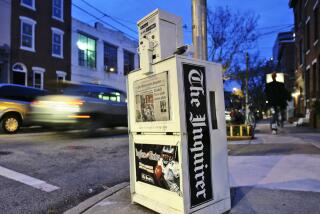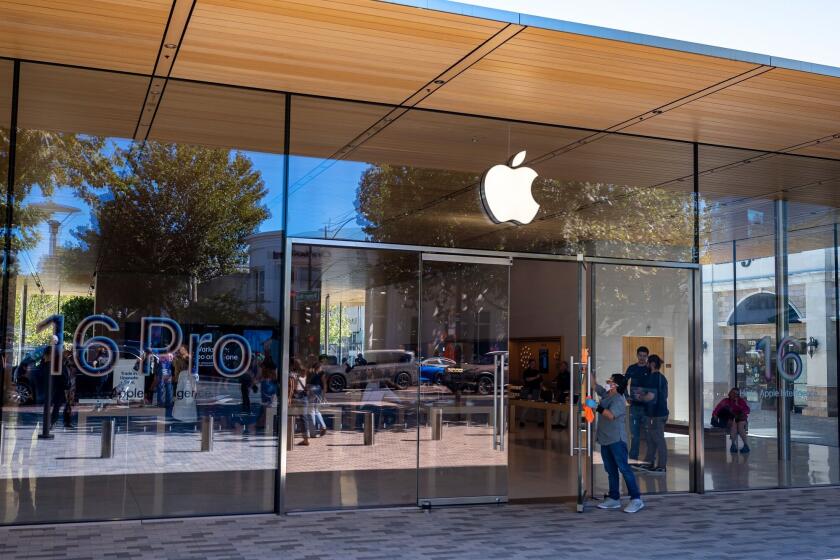On the Media: Will computer tablets help save newspapers?
- Share via
Cash registers should be whirring happily this holiday season with sales of Apple’s iPad, Amazon’s Kindle Fire and other computer tablets. If the wave of buyers behave anything like those who went before, they’ll be spending a lot of time on their new gadgets following the news.
But how best to capture, and profit from, the latest digital phenomenon? Most news companies have placed their bets on building customized tablet applications. Remold your content, produce catchy tablet-specific features and a new generation of readers and advertisers will follow. Or so the theory goes.
One traditional media outpost, though, is trying something more audacious. The publisher of the Philadelphia Inquirer and Daily News has begun selling not only the fruit of its news gathering but one version of the newfangled tree: a French-made, mid-market tablet.
It’s admirable, and about time, to see a newspaper company (one that happens to have a proud tradition of public-service journalism) reaching aggressively for new customers. Too many other print publications have dawdled while their core audience moved to their free websites or slipped away entirely.
But a few days poking around the Arnova 10 G2 tablet and the “Project Liberty” applications leaves the impression that Philadelphia Media Network is not creating enough pop — via breaking news or unique, tabletized features — to build a substantial new beachhead in the fragmenting media landscape. So far, Philadelphia’s 6-week-old offering looks more like a silver BB than a silver bullet.
Chief Executive and Publisher Gregory J. Osberg, who was brought in last year by new owners to rejuvenate the post-bankruptcy Philly papers, which have cut staff sharply, said the newspaper company is not banking on a single strategy. Like other publishers, he will seek multiple new revenue streams. The tablet is one, along with revamped print editions and four paid applications each for the smartphone and the iPad.
So the company once known as a Pulitzer Prize factory now offers smartphone features on the Eagles and Phillies, along with its main Philly.com content and a site for young night life, Phrequency. Other digital offerings, priced at $1.99 and up, are in the pipeline. “We are working toward the tipping point when digital revenue will exceed print revenue and digital users will exceed print readers,” Osberg said in an interview. “When that will occur is the million-dollar question. [But] if you don’t start working on it, it will never happen.”
At the Sept. 12 tablet launch, the publisher predicted that the first batch of 5,000 units would sell out in a week. Six weeks later, only about half of the narrow black computers have moved. “In the exuberance of the promotion, I got a little bit carried away,” said Osberg, predicting, still, that the venture “will be profitable within two years.”
The Philly tablet sales work this way: Customers buy the device at the papers’ headquarters, at mobile kiosks or via the Internet. It comes preloaded with applications for the Inquirer; its sister, the tabloid Daily News; and Philly.com. The Amazon app store and icons for sponsors such as a healthcare provider also appear on the home screen. It costs $285 to get the tablet with the Daily News and Inquirer apps good for one year, $339 for two years. That’s being marketed as a bargain, since home delivery of the print Inquirer stands at $316 a year and the Arnova sells for $220 or more.
The two digitized papers can be downloaded each morning in a couple of minutes via Wi-Fi. What the company calls the “digital” edition looks just like the newspaper, rendered in miniature on the Arnova’s 10-inch screen. Readers turn pages with a swipe of the finger. They open pictures and articles with a tap.
A couple of loyal print readers told me they were drawn in by the cut-rate deal and soon became comfortable with the unfamiliar medium. “Now it feels like getting the paper delivered, but in a different fashion,” said lawyer John Nixon, 48. “It’s been straightforward and pretty easy to use.” (The vast majority of the subscribers are new to the papers, therefore not cannibalizing support for the print product, management said.)
The less print-fixated can download another version of the Inquirer, which looks more like a standard news website in compact form. But there are downsides with either option. Navigation and loading of the editions can at times be halting. Obtaining the latest news — more recent than what was produced for the previous night’s print deadline — requires another click to Philly.com.
The technoscenti will be turned off by this lack of an instantaneous connection (there’s no 3G or 4G connectivity, which is promised for future models) and a cramped, balky keyboard. For others, the chance to get a cut-rate entry into a popular new media platform may be enough. Among other things, it also means access to books and magazines via the Amazon app store.
At least one other news provider, Tribune Co., appears ready to offer its own tablet. The company, publisher of the Los Angeles Times and Chicago Tribune, expects to come out with a device and news package in 2012. The company has not yet revealed details. (Some publishers are also looking at pay “walls” on their standard websites as yet another revenue source.)
A couple of media analysts and investors I spoke to lauded efforts to get into the burgeoning tablet market. But the experts suggested that news companies, rather than start from scratch, would be better served by developing compelling applications and placing them on tablets already being sold by big, established companies, like the iPad, Kindle’s Fire or Barnes and Nobles’ Nook.
News Corp.’s the Daily has tried the premium content approach, though it’s only attracted about a quarter of the users it needs to turn a profit on the tablet-specific site. Downloads of the New York Times’ iPad app have been strong. And a free British commuter paper, Metro, recently drew 155,000 downloads in just 11 days with a splashy, celebrity-heavy variation on the theme.
“If you are offering your own, proprietary tablet from some company people never heard of, you are fighting the market. Nobody wins by fighting the market,” said Alan Mutter, a San Francisco-based media and tech analyst. “You should be publishing to tablets and platforms everyone is already buying, then leveraging that by creating dazzling applications that demand attention.” The Philadelphia execs said they prefer to have control of their product and any proceeds that come from it.
As always, the devil is in the details. But it’s a rare pleasure to report on experimentation in this most conservative of industries, newspapering. May 1,000 tablets, or apps, bloom.
================
Thank you: After more than three years, this is my last On the Media column. I will continue to cover the media beat but the editors have asked me to focus on longer investigations, analysis, profiles and breaking news. I’m looking forward to taking those deeper dives into journalism and culture. Thanks for the many emails — some offering bouquets, others lumps of coal — that kept me in nervous anticipation each time I hit the “send” key on another column.
More to Read
Inside the business of entertainment
The Wide Shot brings you news, analysis and insights on everything from streaming wars to production — and what it all means for the future.
You may occasionally receive promotional content from the Los Angeles Times.










